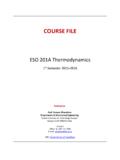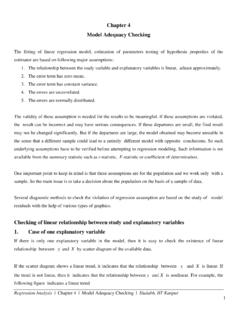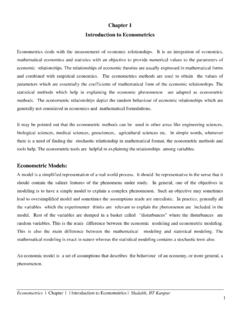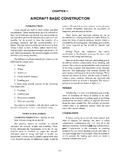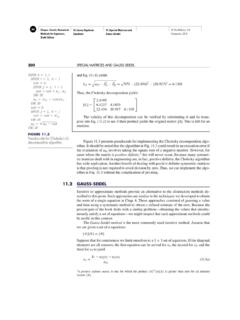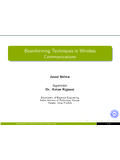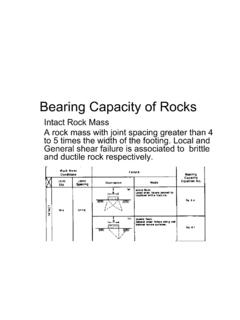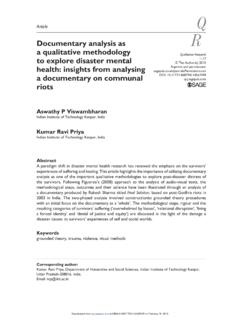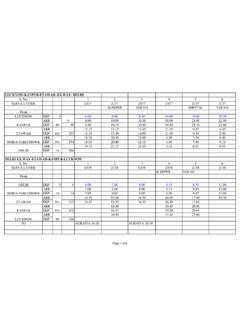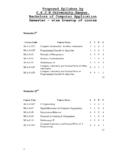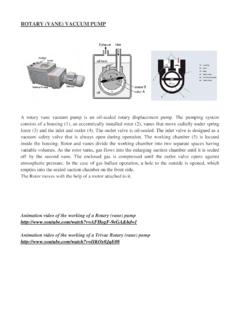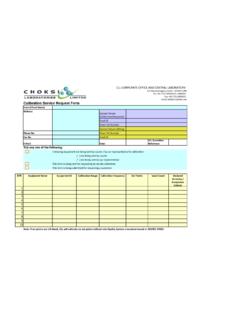Transcription of Chapter 4 Stratified Sampling - IITK
1 Sampling Theory| Chapter 4 | Stratified Sampling | Shalabh, IIT kanpur Page 1 Chapter 4 Stratified Sampling An important objective in any estimation problem is to obtain an estimator of a population parameter which can take care of the salient features of the population. If the population is homogeneous with respect to the characteristic under study, then the method of simple random Sampling will yield a homogeneous sample and in turn, the sample mean will serve as a good estimator of population mean.
2 Thus, if the population is homogeneous with respect to the characteristic under study, then the sample drawn through simple random Sampling is expected to provide a representative sample. Moreover, the variance of sample mean not only depends on the sample size and Sampling fraction but also on the population variance. In order to increase the precision of an estimator, we need to use a Sampling scheme which can reduces the heterogeneity in the population. If the population is heterogeneous with respect to the characteristic under study, then one such Sampling procedure is Stratified Sampling .
3 The basic idea behind the Stratified Sampling is to divide the whole heterogeneous population into smaller groups or subpopulations, such that the Sampling units are homogeneous with respect to the characteristic under study within the subpopulation and heterogeneous with respect to the characteristic under study between/among the subpopulations. Such subpopulations are termed as strata. Treat each subpopulation as separate population and draw a sample by SRS from each stratum.
4 [Note: Stratum is singular and strata is plural]. Example: In order to find the average height of the students in a school of class 1 to class 12, the height varies a lot as the students in class 1 are of age around 6 years and students in class 10 are of age around 16 years. So one can divide all the students into different subpopulations or strata such as Students of class 1, 2 and 3: Stratum 1 Students of class 4, 5 and 6: Stratum 2 Students of class 7, 8 and 9: Stratum 3 Students of class 10, 11 and 12: Stratum 4 Sampling Theory| Chapter 4 | Stratified Sampling | Shalabh, IIT kanpur Page 2 Now draw the samples by SRS from each of the strata 1, 2, 3 and 4.
5 All the drawn samples combined together will constitute the final Stratified sample for further analysis. Notations: We use the following symbols and notations: N : Population size k : Number of strata Ni : Number of Sampling units in ith strata 1kiiNN== ni : Number of Sampling units to be drawn from ith stratum. 1 : Total sample sizekiinn== Population (N units) Stratum 1 N1 units Stratum 2 N2 units Stratum k Nk units .. Sample 1 n1 units Sample 2 n2 units Sample k nk it 1kiiNN== 1kiinn== .. Sampling Theory| Chapter 4 | Stratified Sampling | Shalabh, IIT kanpur Page 3 Procedure of Stratified Sampling Divide the population of N units into k strata.
6 Let the ith stratum has 1,1, 2,..,Nik= number of units. Strata are constructed such that they are non-overlapping and homogeneous with respect to the characteristic under study such that Draw a sample of size in from ith (1, 2,.., )ik= stratum using SRS (preferably WOR) independently from each stratum. All the Sampling units drawn from each stratum will constitute a Stratified sample of size Difference between Stratified and cluster Sampling schemes In Stratified Sampling , the strata are constructed such that they are within homogeneous and among heterogeneous.
7 In cluster Sampling , the clusters are constructed such that they are within heterogeneous and among homogeneous. [Note: We discuss the cluster Sampling later.] Issue in the estimation of parameters in Stratified Sampling Divide the population of N units ink strata. Let the ith stratum has ,1, 2,..,iNik= number of units. Note that there are k independent samples drawn through SRS of sizes 12, ,..,knnn from each of the strata. So, one can have k estimators of a parameter based on the sizes 12.
8 ,knnn respectively. Our interest is not to have k different estimators of the parameters but the ultimate goal is to have a single estimator. In this case, an important issue is how to combine the different sample information together into one estimator which is good enough to provide the information about the parameter. We now consider the estimation of population mean and population variance from a Stratified sample. Sampling Theory| Chapter 4 | Stratified Sampling | Shalabh, IIT kanpur Page 4 Estimation of population mean and its variance Let :Ycharacteristic under study, :ijyvalue of jth unit in ith stratum j = 1,2.
9 ,ni, i = 1,2,..,k, 11:iNiijjiYyN== population mean of ith stratum 11:iniijjiyyn== sample mean from ith stratum 111:kkiiiiiiYN YwYN==== population mean where .iiNwN= Estimation of population mean: First we discuss the estimation of population mean. Note that the population mean is defined as the weighted arithmetic mean of stratum means in the case of Stratified Sampling where the weights are provided in terms of strata sizes. Based on the expression 11,kiiiYNYN== one may choose the sample mean 11kiiiynyn== as a possible estimator of Y.
10 Since the sample in each stratum is drawn by SRS, so () ,iiEyY= thus 111()( )1kiiikiiiEynEynnYnY==== Sampling Theory| Chapter 4 | Stratified Sampling | Shalabh, IIT kanpur Page 5 and y turns out to be a biased estimator of Y. Based on this, one can modify y so as to obtain an unbiased estimator of Y. Consider the stratum mean which is defined as the weighted arithmetic mean of strata sample means with strata sizes as weights given by Now 111( )()1kstiiikiiiEyNEyNNYNY===== Thus sty is an unbiased estimator of Y.
